Home | Tours | Trip Reports | News | Team | Calendar | Links | Contact | Store | Mailing List

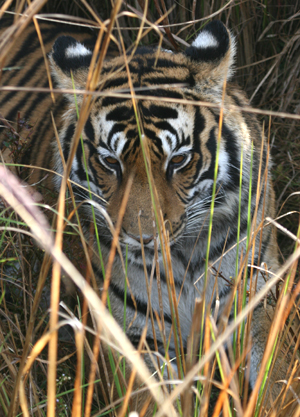 INDIA:
INDIA:
Birds, Tigers, & the Taj Mahal
November 21 - December 5, 2008
Trip Report
All photos © Peg Abbott
SPECIES LIST>>(pdf ) PDF Report>>(pdf)
LEADERS: Peg Abbott & Avijit Sarkhel
Friday, November 21 - Early Arrival, Delhi
Our journey to discover the wonders of India began early for several of us who wanted to explore the city highlights of Delhi before going off to the bush. We started with a relaxing morning to check out birds in the garden and enjoy a leisurely breakfast. Our morning prowl was worthwhile, revealing Rufous Treepies, Jungle Babblers, House Crows, Purple Sunbirds, Common Mynas and stunning Rose-ringed Parakeets that were feeding in nectar- rich flowers.
The sun broke through the wet morning haze and by 9:00 we tucked into a comfortable Toyota with a local driver and guide. Johnston, the driver, was most personable, describing his family, his marriage, customs and 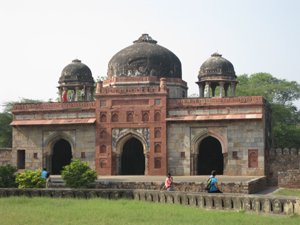 types of vehicles on the road and small details of city life. Both answered our endless questions and shared facts about the major buildings we encountered. Our first stop was at Humayun's Tomb, a mausoleum thought to have been a great influence on the design of the Taj Mahal. While the style lines appear to match up, this tomb is constructed of the massive, bold and intriguing red sandstone used in so many of the area’s early buildings. The effect of the place was stunning and bold – much bolder than any photo can convey. Here was symmetry on a large scale, seen at all levels from gardens to decorations. Channels of water fanned out in four directions. Side tombs are located in within view – each with their own grace and story. We enjoyed watching people as well: a group of school children on a field trip, a young woman dancing with arms high on the plaza, Indian women dressed in such colorful finery and wonderful facial features.
types of vehicles on the road and small details of city life. Both answered our endless questions and shared facts about the major buildings we encountered. Our first stop was at Humayun's Tomb, a mausoleum thought to have been a great influence on the design of the Taj Mahal. While the style lines appear to match up, this tomb is constructed of the massive, bold and intriguing red sandstone used in so many of the area’s early buildings. The effect of the place was stunning and bold – much bolder than any photo can convey. Here was symmetry on a large scale, seen at all levels from gardens to decorations. Channels of water fanned out in four directions. Side tombs are located in within view – each with their own grace and story. We enjoyed watching people as well: a group of school children on a field trip, a young woman dancing with arms high on the plaza, Indian women dressed in such colorful finery and wonderful facial features.
Dogs here sleep like the dead. We found one stretched out on the wall asleep in the sun, another nursing 5 or more frisky pups. We lingered here as the site was so impressive, but soon our guide moved us on – more to see on our big day afield in Delhi.
We drove and drove; Peg snapped photos out the window of markets and cars and bicycles loaded high with gear. We passed every kind of store imaginable, selling electronics to live chickens. The hustle and bustle was incredible, but not as difficult to observe as I had imagined. We passed from New (modern) Delhi to Old Delhi and the hustle and bustle increased four-fold. The famed Red Fort looked more immense than we could take in on our one short day and we opted to see it from the exterior (most impressive!) and take in some other more intimate sights. From a viewpoint of the Fort on a busy street we were whisked away on bicycle rickshaws, two passengers with one strong, clever man peddling. Oh my! One has to experience this at least once in life. We threaded through traffic of every ilk, from trucks to cars to auto-rickshaws to cargo bicycles and more. People  were everywhere, packed in tight, all moving, talking, bargaining in myriad vendor stalls. There were beautiful rows of breads, stands with fruit piled high and meat hanging in the hot sun. There were plastic gadgets, McDonald's hamburgers, and auto parts, all set up under electric lines totally exposed – crossed by Rhesus Macaque monkeys as if they were forest vines.
were everywhere, packed in tight, all moving, talking, bargaining in myriad vendor stalls. There were beautiful rows of breads, stands with fruit piled high and meat hanging in the hot sun. There were plastic gadgets, McDonald's hamburgers, and auto parts, all set up under electric lines totally exposed – crossed by Rhesus Macaque monkeys as if they were forest vines.
The ride was so unreal it passed as if in seconds and we disembarked near the largest mosque in Delhi. As we neared the entry they signaled us away as mid-day prayers were starting. We looked in at men laying prayer mats down in quantity that enough for 1000. Indeed, our guide says this one mosque holds 20,000. Prayers uttered five times per day. What a glimpse into an exotic realm! Our driver was diligent about finding us just as we were ready to go. We were whisked away and often gripped our handles as Johnston wove between massive amounts of moving traffic. Amid the chaos we’d see two old men walking mid-street, chatting as if in a quiet garden park. It was unbelievable, all this tolerance of humankind in such numbers. As Johnston says, “You cannot drive without a horn in India”. Horn sounds was with us all day. That and calls to prayer, salutes across busy streets to comrades or business partners, and pleas from children for us to buy baskets with little paper cobras popping out, jeweled diaries, fat Buddha sculptures. The messages we read and experienced at the very moving Gandhi Memorial came into new context as we witnessed such the panoply of people in the streets. Peace for the world, can we ever hope?
Our private lunch in the home of a delightful, outgoing and gracious couple was a highlight of our day. They welcomed us into their home, a place full of art with peaceful gardens in view out wide windows. Sunlight poured in as we shared stories over a delicious bouquet of flavors prepared by our hostess. She selected a mix of dishes to tempt us to try new foods – spinach paneer, chicken curry, a lentil dish with subtle spice, and potatoes in yoghurt – so delicious. This was all accompanied by hot Roti bread and we ended the meal with a 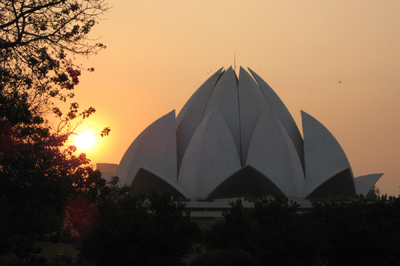 delightfully spiced Indian rice pudding. We ate leisurely, enjoying the moment and finally bid our hosts adieu. Our patient guide wanted us to see and experience everything we mentioned, and thus we found ourselves shopping in a store well stocked with rugs, textiles, jewelry, woodcraft – you name it. We did our part for the local economy and moved on.
delightfully spiced Indian rice pudding. We ate leisurely, enjoying the moment and finally bid our hosts adieu. Our patient guide wanted us to see and experience everything we mentioned, and thus we found ourselves shopping in a store well stocked with rugs, textiles, jewelry, woodcraft – you name it. We did our part for the local economy and moved on.
One more stop – the amazing Bahai Temple reminiscent of the Sydney Opera House and known as the Lotus Temple. We got there just at sunset, and were delighted to witness a few moments of quiet prayer and chanting. The inside of the building was as impressive as the outside – fantastic acoustics between the 27 petals, surrounded by 9 ponds. A great end to the day! Then it was back to our most comfortable hotel to regroup and prepare for nature the next day.
Saturday, November 22 - Sultanpur National Park
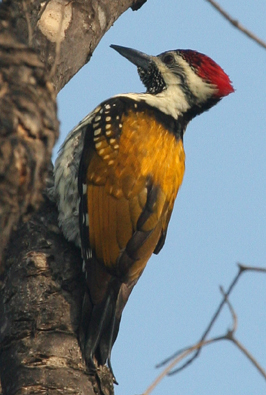 Several of us walked in the garden of our hotel at first light, enjoying the sense of familiarity with the garden birds. Marge and Dwayne had made fast friends with many of the staff by sharing their scope and bird sightings. Now members of the staff were luring Jungle Babblers in, feeding crumbs to them with delight. We met Avi and Harish, our guides at breakfast and soon were negotiating the streets of Delhi to travel west of the city for our first day of birding. Morning in Delhi is resoundingly busy. Humankind was everywhere, en masse on the road in every type of conveyance imaginable. Many were waking up from makeshift street beds, others had made more permanent squatter homes within culverts or store fronts and under large trees or vehicles. On the streets many were cooking or just sitting, contemplating their day, as we do in gardens or living rooms. Men were prevalent, often in groups, but women appeared as bright jewels in the dust and gray of street life. They were impeccably dressed in traditional clothing and colorful shawls, often carrying babies or groceries, waiting for buses. Some perched side-saddle on motorcycles driven by husbands, others clutched young children's hands as they tried to cross traffic-soaked streets. We traveled quietly, taking it all in. At times Harish would interpret a scene – an avenue decorated for an upcoming wedding, vendors selling prayer cloth near a Hindu Temple, political signs for upcoming elections, Rhesus Monkeys careening about the electric wires. After an hour or so we crossed the state line into Haryana, which had a less-crowded, seemingly modern business area followed by rural villages and zones of agriculture. The soil looked rich; farmers plowed with tractors and those living with little, clustered in fields under shading trees. We saw camels, donkeys, horses and bicycles pulling improbable loads and watched as enormous truck convoys headed in to Delhi. Trucks, like women, are colorful. Their fronts were painted with bright patterns, their rears with signs ‘blow your horn’.
Several of us walked in the garden of our hotel at first light, enjoying the sense of familiarity with the garden birds. Marge and Dwayne had made fast friends with many of the staff by sharing their scope and bird sightings. Now members of the staff were luring Jungle Babblers in, feeding crumbs to them with delight. We met Avi and Harish, our guides at breakfast and soon were negotiating the streets of Delhi to travel west of the city for our first day of birding. Morning in Delhi is resoundingly busy. Humankind was everywhere, en masse on the road in every type of conveyance imaginable. Many were waking up from makeshift street beds, others had made more permanent squatter homes within culverts or store fronts and under large trees or vehicles. On the streets many were cooking or just sitting, contemplating their day, as we do in gardens or living rooms. Men were prevalent, often in groups, but women appeared as bright jewels in the dust and gray of street life. They were impeccably dressed in traditional clothing and colorful shawls, often carrying babies or groceries, waiting for buses. Some perched side-saddle on motorcycles driven by husbands, others clutched young children's hands as they tried to cross traffic-soaked streets. We traveled quietly, taking it all in. At times Harish would interpret a scene – an avenue decorated for an upcoming wedding, vendors selling prayer cloth near a Hindu Temple, political signs for upcoming elections, Rhesus Monkeys careening about the electric wires. After an hour or so we crossed the state line into Haryana, which had a less-crowded, seemingly modern business area followed by rural villages and zones of agriculture. The soil looked rich; farmers plowed with tractors and those living with little, clustered in fields under shading trees. We saw camels, donkeys, horses and bicycles pulling improbable loads and watched as enormous truck convoys headed in to Delhi. Trucks, like women, are colorful. Their fronts were painted with bright patterns, their rears with signs ‘blow your horn’.
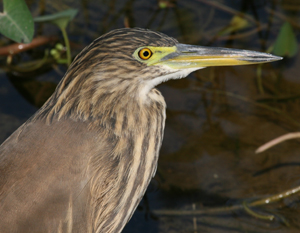 Soon we were spotting birds in fields and on wires: Red-wattled Lapwings, Indian Rollers, Asian Pied Starlings, and a Common Hoopoe. We arrived at our destination about 10:00 AM and for the most part had the place to ourselves at the start of our walk. Avi and Harish wasted no time in finding us birds: Black Redstarts, several Old World warblers, Large Grey Babblers, Small Minivets, Oriental White-eyes and Oriental Magpie Robins. The sightings came quickly – Peg tried to back up identifications with the field guide for quick reference. A Black-rumped Flameback (woodpecker) was a knock-out and Rufous Treepies put on a good show for all. Some species were quick and secretive, like the Greater Coucal. Painted Cranes were everywhere, flying, some carrying nest materials, many on nests on mid-lake islands, attending large and hungry chicks. There were hundreds, if not thousands, of ducks. An unknown raptor, or perhaps the multitudes of arriving school children mid-day, kept putting them up. We watched wheeling clouds of Common Teals, Northern Shovelers and Northern Pintails. Purple Gallinules feed in tall reeds and we found a good array of local herons, the Indian Pond Heron juvenile being new for many of us. Shikras, pale and bold accipiter hawks, perched boldly on several locations and we spotted one winter migrant Eurasian Sparrowhawk. Our walk turned out to be a hike of several miles, and as the temperature climbed, we chose to head in to lunch – delicious Indian food prepared at a local nearby resort. As we came out of the reserve there were several school groups gathered on the lawn and it was fun to see their bright smiles. Fran talked with several of the college-age students all eager to practice their English. The park warden showed her two excellent display areas, one on the grandfather of Indian ornithology and the other on local birds. Tired, and with full bellies, several people napped en route back to the hotel while others simply took in the relentless motion of traffic and small-scale commerce that marks the streets of India. We got back about 3:30 PM and Marge and Dwayne found their Brown-headed Barbet active in the garden. Several of us took power naps (some longer than others!). Mark and Linda arrived with no flight delays, so by dinner our group was complete. A fun surprise was having Penny’s son and friend join us for dinner. They are both in the travel industry and surprised her by coming in from London. They’d be off the next day to take in some of the historic sites; this evening we enjoyed lively conversation.
Soon we were spotting birds in fields and on wires: Red-wattled Lapwings, Indian Rollers, Asian Pied Starlings, and a Common Hoopoe. We arrived at our destination about 10:00 AM and for the most part had the place to ourselves at the start of our walk. Avi and Harish wasted no time in finding us birds: Black Redstarts, several Old World warblers, Large Grey Babblers, Small Minivets, Oriental White-eyes and Oriental Magpie Robins. The sightings came quickly – Peg tried to back up identifications with the field guide for quick reference. A Black-rumped Flameback (woodpecker) was a knock-out and Rufous Treepies put on a good show for all. Some species were quick and secretive, like the Greater Coucal. Painted Cranes were everywhere, flying, some carrying nest materials, many on nests on mid-lake islands, attending large and hungry chicks. There were hundreds, if not thousands, of ducks. An unknown raptor, or perhaps the multitudes of arriving school children mid-day, kept putting them up. We watched wheeling clouds of Common Teals, Northern Shovelers and Northern Pintails. Purple Gallinules feed in tall reeds and we found a good array of local herons, the Indian Pond Heron juvenile being new for many of us. Shikras, pale and bold accipiter hawks, perched boldly on several locations and we spotted one winter migrant Eurasian Sparrowhawk. Our walk turned out to be a hike of several miles, and as the temperature climbed, we chose to head in to lunch – delicious Indian food prepared at a local nearby resort. As we came out of the reserve there were several school groups gathered on the lawn and it was fun to see their bright smiles. Fran talked with several of the college-age students all eager to practice their English. The park warden showed her two excellent display areas, one on the grandfather of Indian ornithology and the other on local birds. Tired, and with full bellies, several people napped en route back to the hotel while others simply took in the relentless motion of traffic and small-scale commerce that marks the streets of India. We got back about 3:30 PM and Marge and Dwayne found their Brown-headed Barbet active in the garden. Several of us took power naps (some longer than others!). Mark and Linda arrived with no flight delays, so by dinner our group was complete. A fun surprise was having Penny’s son and friend join us for dinner. They are both in the travel industry and surprised her by coming in from London. They’d be off the next day to take in some of the historic sites; this evening we enjoyed lively conversation.
Sunday, November 23 - Travel Day to Bharatpur
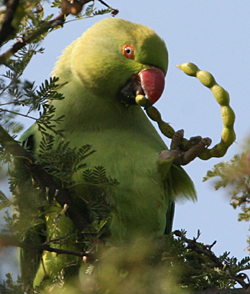 We enjoyed some time to have breakfast and go out to see the birds of the garden, where it appeared that a pair of Rose-ringed Parakeets had successfully commandeered a prize nest hole from the Brown-headed Barbets. A wedding party was coming in so there was a lot of activity. We were packed and on the road by 8:30 AM. We knew that it would be a travel day with intermittent stops en route for birding. We could not imagine all that we would see this day – in both the human realm and that of nature. It was a full two hours until we got even a small break from the street vendor scene that defines Delhi. Not a spare patch of ground goes unused. Street commerce of every description commences early. People sit in small booths decorated with lottery tickets while others sell scraps of metal, wood, rubber to fix bicycle tires, scarves, chickens, vegetables, colorful plastic tubs. You name it, it is there, if you can get through the sea of humanity on every side of it. All vehicles relentlessly blow horns as they navigate the chaos of horse carts, ox carts, motorcycles, motor rickshaws, bicycles, bicycle rickshaws, cars, trucks and the occasional camel. Amid all this, the women look beautiful clad in bright fabric -- as beautiful as any of the birds we see. They are often holding children as they wait for a bus, or going off to work. Men are busy everywhere. Those that aren’t busy enjoy each other's company oblivious to all the commotion. The scene changes little, perpetual motion; we find ourselves in a sort of trance as the bus moves on. We try to take it all in. A few of our group have returned to sleep; others read, try to photograph out the window or to study birds we soon hope to see.
We enjoyed some time to have breakfast and go out to see the birds of the garden, where it appeared that a pair of Rose-ringed Parakeets had successfully commandeered a prize nest hole from the Brown-headed Barbets. A wedding party was coming in so there was a lot of activity. We were packed and on the road by 8:30 AM. We knew that it would be a travel day with intermittent stops en route for birding. We could not imagine all that we would see this day – in both the human realm and that of nature. It was a full two hours until we got even a small break from the street vendor scene that defines Delhi. Not a spare patch of ground goes unused. Street commerce of every description commences early. People sit in small booths decorated with lottery tickets while others sell scraps of metal, wood, rubber to fix bicycle tires, scarves, chickens, vegetables, colorful plastic tubs. You name it, it is there, if you can get through the sea of humanity on every side of it. All vehicles relentlessly blow horns as they navigate the chaos of horse carts, ox carts, motorcycles, motor rickshaws, bicycles, bicycle rickshaws, cars, trucks and the occasional camel. Amid all this, the women look beautiful clad in bright fabric -- as beautiful as any of the birds we see. They are often holding children as they wait for a bus, or going off to work. Men are busy everywhere. Those that aren’t busy enjoy each other's company oblivious to all the commotion. The scene changes little, perpetual motion; we find ourselves in a sort of trance as the bus moves on. We try to take it all in. A few of our group have returned to sleep; others read, try to photograph out the window or to study birds we soon hope to see.
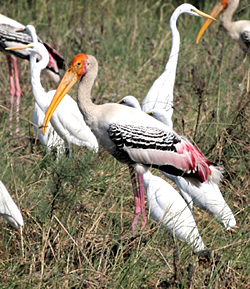 We pass a bit of agricultural land and traffic and the perpetual frenzy let up a bit. Near a set of ponds we stop the bus in the road, taking up one active lane of traffic which no one seems to find odd. Indeed they seem to enjoy slowing down to watch us tromp (carefully) down toward a pond. We are oblivious as there are birds galore to feast our eyes on. We point our scopes and binoculars Painted Storks, herons of all varieties, a Glossy Ibis, and a host of shorebirds. With them we pull out views of Common Snipes, Wood Sandpipers, Common Red shanks, Common Sandpipers. Children and old men come to shadow our movements. One boy carries a basket and when he opens the lid a cobra pops out. Live and in the flesh but, Avi assures us, milked of its poisons. We go back to birding and identify Short-toed Eagles and Egyptian Vultures above. Penny smiles brightly and sighs – “This is wonderful!” We look until we’ve covered two ponds well. Soon after getting back on the road we stop for lunch at a tourist rest where boys try to show us more cobras while Rhesus Macaque monkeys parade around. One male on the prowl looks as if he has two large pink balloons swaying with every step as he follows a female – we move out of his way. Lunch is delicious and well prepared and soon we are on our way. The afternoon reveals more rural scenery. Though villages are still action packed, the vendors carry more utilitarian goods. We stop for road construction and observe women working with vigor to shape, dry and stack tall piles of cow dung. On a multi-storied construction, men standing on a scaffold of bamboo, hand open pails of cement up several stories. Those at the top dump them into forms and reach for another round. Harish signals a stop at a dreadfully dirty river crossing. It stinks, but we close our nostrils as we have hopes of finding Painted Snipes, beautiful birds in a unique family – a new species for all members of our group. We find them and then get distracted by a female Ruff, bright White-breasted Water Hens, and numerous Black-winged Stilts. Harish finds them and we all get close looks in the scope, admiring the bright plumage of the female, which like our phalarope takes on the role and plumage of the male. Closer to Bharatpur, we notice more prosperity that Avi credits money from tourism for creating. Marge and Fran had watched CBS Sunday Morning’s clips of this World Heritage Preserve and its Painted Stork rookery just last Sunday. In town we pass colorful stucco homes, some of which have Christmas lights. We are happy to arrive and are enthralled by the décor of our hotel. We have yet to learn about the music of happy wedding feasts that will go on all night, each night. We eat some wonderful dishes of similar ingredients but new textures and flavors. Our bird list is pretty amazing for a travel day – 65 species, 29 of them new!
We pass a bit of agricultural land and traffic and the perpetual frenzy let up a bit. Near a set of ponds we stop the bus in the road, taking up one active lane of traffic which no one seems to find odd. Indeed they seem to enjoy slowing down to watch us tromp (carefully) down toward a pond. We are oblivious as there are birds galore to feast our eyes on. We point our scopes and binoculars Painted Storks, herons of all varieties, a Glossy Ibis, and a host of shorebirds. With them we pull out views of Common Snipes, Wood Sandpipers, Common Red shanks, Common Sandpipers. Children and old men come to shadow our movements. One boy carries a basket and when he opens the lid a cobra pops out. Live and in the flesh but, Avi assures us, milked of its poisons. We go back to birding and identify Short-toed Eagles and Egyptian Vultures above. Penny smiles brightly and sighs – “This is wonderful!” We look until we’ve covered two ponds well. Soon after getting back on the road we stop for lunch at a tourist rest where boys try to show us more cobras while Rhesus Macaque monkeys parade around. One male on the prowl looks as if he has two large pink balloons swaying with every step as he follows a female – we move out of his way. Lunch is delicious and well prepared and soon we are on our way. The afternoon reveals more rural scenery. Though villages are still action packed, the vendors carry more utilitarian goods. We stop for road construction and observe women working with vigor to shape, dry and stack tall piles of cow dung. On a multi-storied construction, men standing on a scaffold of bamboo, hand open pails of cement up several stories. Those at the top dump them into forms and reach for another round. Harish signals a stop at a dreadfully dirty river crossing. It stinks, but we close our nostrils as we have hopes of finding Painted Snipes, beautiful birds in a unique family – a new species for all members of our group. We find them and then get distracted by a female Ruff, bright White-breasted Water Hens, and numerous Black-winged Stilts. Harish finds them and we all get close looks in the scope, admiring the bright plumage of the female, which like our phalarope takes on the role and plumage of the male. Closer to Bharatpur, we notice more prosperity that Avi credits money from tourism for creating. Marge and Fran had watched CBS Sunday Morning’s clips of this World Heritage Preserve and its Painted Stork rookery just last Sunday. In town we pass colorful stucco homes, some of which have Christmas lights. We are happy to arrive and are enthralled by the décor of our hotel. We have yet to learn about the music of happy wedding feasts that will go on all night, each night. We eat some wonderful dishes of similar ingredients but new textures and flavors. Our bird list is pretty amazing for a travel day – 65 species, 29 of them new!
Monday, November 24 - Bharatpur
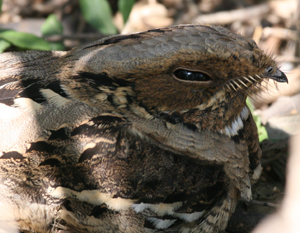 Marge and Dwayne would call today, at its end, as one of the best birding days of their lives. Many of us would agree – it was just a stunning day! We had breakfast early and arrived at (Keoladeo NP) also known as Bharatpur Reserve by 7:00 AM. We were sighting new species on the phone wires as Avi paid our entry fees. Local birding guides were lined up to drive us on a network of paths that give access to the ponds and wetland habitats of this 29 sq. km. area. We were invited two by two onto our bicycle rickshaws – scopes, cameras and all. Tirelessly, these fine men peddle us about. They stopped with precision, knowing just how to place us to see a bird or take a photo. They had several owl nests scoped out and within minutes of our arrival we’d had great looks at Spotted Owlets with grown chicks and a Dusky Eagle Owl tucked down in its nest. Close to this area we found Orange-headed Thrushes which hid out while feeding along the shoreline. We could hear the stork rookery before we got there. It was ablaze with activity and we stopped to watch as birds brought in nest material or food for chicks. There were chicks of varying age, from downy white young to sooty headed juveniles. Other herons, Great Cormorants and Black-headed Ibis were mixed into the nesting frenzy. It was wonderful to hear nature’s cacophony – music to our ears. We then headed out to take in whatever we found. We had perfect visibility as the bicycle wheels spun round and round. Quiet was heavenly. We found a steady stream of birds that would end with a day’s tally of 118 species, 43 of them new to our list. Highlights were numerous. Purple Herons posed close to the trail and with luck we found both Woolly-necked and Black-necked Storks. Asian Openbills were furtive but present. Harish had staked out a Long-tailed Nightjar that we got up close and personal with. We had some great flight dramas of Marsh Harriers and Greater Spotted Eagles putting up thousands of ducks that would whirl in the sky. Lesser Whistling Ducks were easy to pick out uttering high pitched sounds quite in contrast with the almost barking call of Bar-headed Geese. In quieter times, we admired Comb and Indian Spot-billed Ducks and admired a few familiar to us such as Northern Pintails and Northern Shovelers. Grey Francolins waddled across the roads while, in the water, colors of Purple Swamphens and Red-wattled Lapwings drew our attention. White-eared Bulbuls were seen several times during the day and we started to recognize three species of shrikes: Long-tailed, Brown and Southern Grey. From that first Oriental Magpie Robin in the parking lot, to the Flat-shelled Terrapin and a grand array of butterflies – it was a magical day!
Marge and Dwayne would call today, at its end, as one of the best birding days of their lives. Many of us would agree – it was just a stunning day! We had breakfast early and arrived at (Keoladeo NP) also known as Bharatpur Reserve by 7:00 AM. We were sighting new species on the phone wires as Avi paid our entry fees. Local birding guides were lined up to drive us on a network of paths that give access to the ponds and wetland habitats of this 29 sq. km. area. We were invited two by two onto our bicycle rickshaws – scopes, cameras and all. Tirelessly, these fine men peddle us about. They stopped with precision, knowing just how to place us to see a bird or take a photo. They had several owl nests scoped out and within minutes of our arrival we’d had great looks at Spotted Owlets with grown chicks and a Dusky Eagle Owl tucked down in its nest. Close to this area we found Orange-headed Thrushes which hid out while feeding along the shoreline. We could hear the stork rookery before we got there. It was ablaze with activity and we stopped to watch as birds brought in nest material or food for chicks. There were chicks of varying age, from downy white young to sooty headed juveniles. Other herons, Great Cormorants and Black-headed Ibis were mixed into the nesting frenzy. It was wonderful to hear nature’s cacophony – music to our ears. We then headed out to take in whatever we found. We had perfect visibility as the bicycle wheels spun round and round. Quiet was heavenly. We found a steady stream of birds that would end with a day’s tally of 118 species, 43 of them new to our list. Highlights were numerous. Purple Herons posed close to the trail and with luck we found both Woolly-necked and Black-necked Storks. Asian Openbills were furtive but present. Harish had staked out a Long-tailed Nightjar that we got up close and personal with. We had some great flight dramas of Marsh Harriers and Greater Spotted Eagles putting up thousands of ducks that would whirl in the sky. Lesser Whistling Ducks were easy to pick out uttering high pitched sounds quite in contrast with the almost barking call of Bar-headed Geese. In quieter times, we admired Comb and Indian Spot-billed Ducks and admired a few familiar to us such as Northern Pintails and Northern Shovelers. Grey Francolins waddled across the roads while, in the water, colors of Purple Swamphens and Red-wattled Lapwings drew our attention. White-eared Bulbuls were seen several times during the day and we started to recognize three species of shrikes: Long-tailed, Brown and Southern Grey. From that first Oriental Magpie Robin in the parking lot, to the Flat-shelled Terrapin and a grand array of butterflies – it was a magical day!
Tuesday, November 25 - Return to Bharatpur
This morning we returned to Bharatpur. Hopping on our rickshaws as if it were the normal means of transport we were ready to explore. There were so many species to sort out yesterday that today gave us time to study them in more detail and to find the few that we had missed. The rickshaw drivers were there to greet us and we had another good weather day with blue sky breaking through the persistent haze. Highlights included watching the behavior of a troop of Rhesus Macaques with their many curious youngsters. We did a bit of damage in the park’s gift store on our return, loading up on bird prints, field guides and T-shirts. Dwayne found a great vest with the logo of the White-breasted Kingfisher. The afternoon/evening outing was optional for 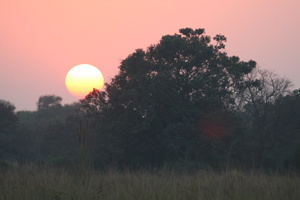 those who wanted to get a bit more time in the park and a chance to see a variety of harriers coming in to roost in a more remote part of the sanctuary. Several of the group opted to enjoy time to relax at the lovely hotel, while others boarded a small bus that could take us farther into the reserve in a short amount of time. Our rickshaw drivers smiled and waved – a bit disappointed that we were not again going to join them. We zoomed past the Painted Stork rookery, past the abandoned, former Moghul’s hunting lodge, finally arriving at a dam of sorts that created flooded fields, now dry. We had scope views of Black Grouse, new for our list and worked on some shorebirds, including Common Snipes that were in the canal at close range. Several harriers began to come in, mainly the eastern race of Western Marsh Harrier, of which we got splendid views. The day ended with a bang for Mary Clair and M.J. who enjoyed good looks at a Jungle Cat as it trotted down an intersecting road. Wow!
those who wanted to get a bit more time in the park and a chance to see a variety of harriers coming in to roost in a more remote part of the sanctuary. Several of the group opted to enjoy time to relax at the lovely hotel, while others boarded a small bus that could take us farther into the reserve in a short amount of time. Our rickshaw drivers smiled and waved – a bit disappointed that we were not again going to join them. We zoomed past the Painted Stork rookery, past the abandoned, former Moghul’s hunting lodge, finally arriving at a dam of sorts that created flooded fields, now dry. We had scope views of Black Grouse, new for our list and worked on some shorebirds, including Common Snipes that were in the canal at close range. Several harriers began to come in, mainly the eastern race of Western Marsh Harrier, of which we got splendid views. The day ended with a bang for Mary Clair and M.J. who enjoyed good looks at a Jungle Cat as it trotted down an intersecting road. Wow!
Wednesday, November 26 - Taj Mahal
 What a day! We woke very early to board our bus by 5 AM as we wanted to be at the Taj Mahal when they opened the gates at dawn. We made good time, picked up our local guide and passed through security. We spent several hours, on our own and with the informative guide, admiring details small and large. This is truly a World Heritage site and one of the most impressive buildings any of us had ever seen. It was fascinating to see how these early architects repeated design elements from the massive red sandstone gateway building to the fine white marble massif of the Taj itself. Sadly there was a lot of haze, which made photography difficult when shooting against gray sky. But we did well with detail – taking close-up photos of fine inlaid tile and intricate floral carvings. We marveled at the color and array and sheer quantity of gemstones. Our guide shone a light to bring out the translucent quality of carnelian, wow! We all kept saying that it was just so much more beautiful than we imagined. We left the Taj in the sort of daze that comes on when one is overwhelmed. Avi took us for a delightful buffet at an all too fancy tourist hotel – we were not used to these digs! While we fully enjoyed the fine bathrooms and food, we longed for our simpler lodgings more in tune with nature and culture. Fortified, we left the busy city of Agra and ventured on through rural villages teeming with life. Once again the vivid street scenes out the window will be with us always: children getting water at the community well, a man walking with a calf draped over his shoulders, women rounding cow patties into stacks of usable fuel. At times we’d pass some invisible line between ‘residential’ and commercial and then the streets would narrow due to tight packed vendor stalls taking up every inch of road space. Men pushed bicycles loaded with heavy steel and copper pipe. Men got shaved at single chair, outside barber stalls. There were auto shops, bicycle repair, tailors, and a man and son ironing shirts. Cashews cooked in huge metal bins and vegetables were piled high next to racks of chicken cages and sacks of flour. We arrived at Chambal River Lodge for a late lunch, beautifully presented in copper serving dishes lined up on bright linens. Tables and chairs were set outside in the garden and the staff was smiling and ready to greet us. What a pleasant place – and – full of birds! A Brown-headed Barbet peeked over the roof at us as we ate and Jungle Babblers kept up a constant chatter as they bathed in an irrigated part of the flower beds. Avi and the local guides led us for a bird walk around 4 PM, on which we got excellent looks at Yellow-footed Green Pigeons, Indian Gray Hornbills, Thick-billed Flowerpeckers and a very intent Shikra. We gathered around a campfire to chat before our meal. Dinner was in the cozy inside dining room, where historic photos of the property graced the walls. They really outdid themselves, preparing specialty Indian dishes passed down for generations in the family.
What a day! We woke very early to board our bus by 5 AM as we wanted to be at the Taj Mahal when they opened the gates at dawn. We made good time, picked up our local guide and passed through security. We spent several hours, on our own and with the informative guide, admiring details small and large. This is truly a World Heritage site and one of the most impressive buildings any of us had ever seen. It was fascinating to see how these early architects repeated design elements from the massive red sandstone gateway building to the fine white marble massif of the Taj itself. Sadly there was a lot of haze, which made photography difficult when shooting against gray sky. But we did well with detail – taking close-up photos of fine inlaid tile and intricate floral carvings. We marveled at the color and array and sheer quantity of gemstones. Our guide shone a light to bring out the translucent quality of carnelian, wow! We all kept saying that it was just so much more beautiful than we imagined. We left the Taj in the sort of daze that comes on when one is overwhelmed. Avi took us for a delightful buffet at an all too fancy tourist hotel – we were not used to these digs! While we fully enjoyed the fine bathrooms and food, we longed for our simpler lodgings more in tune with nature and culture. Fortified, we left the busy city of Agra and ventured on through rural villages teeming with life. Once again the vivid street scenes out the window will be with us always: children getting water at the community well, a man walking with a calf draped over his shoulders, women rounding cow patties into stacks of usable fuel. At times we’d pass some invisible line between ‘residential’ and commercial and then the streets would narrow due to tight packed vendor stalls taking up every inch of road space. Men pushed bicycles loaded with heavy steel and copper pipe. Men got shaved at single chair, outside barber stalls. There were auto shops, bicycle repair, tailors, and a man and son ironing shirts. Cashews cooked in huge metal bins and vegetables were piled high next to racks of chicken cages and sacks of flour. We arrived at Chambal River Lodge for a late lunch, beautifully presented in copper serving dishes lined up on bright linens. Tables and chairs were set outside in the garden and the staff was smiling and ready to greet us. What a pleasant place – and – full of birds! A Brown-headed Barbet peeked over the roof at us as we ate and Jungle Babblers kept up a constant chatter as they bathed in an irrigated part of the flower beds. Avi and the local guides led us for a bird walk around 4 PM, on which we got excellent looks at Yellow-footed Green Pigeons, Indian Gray Hornbills, Thick-billed Flowerpeckers and a very intent Shikra. We gathered around a campfire to chat before our meal. Dinner was in the cozy inside dining room, where historic photos of the property graced the walls. They really outdid themselves, preparing specialty Indian dishes passed down for generations in the family.
Thursday, November 27 - Chambal River
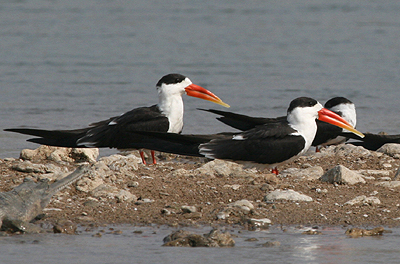 Terrible news rocked India today. Terrorists had attacked two five star hotels in Mumbai (formerly Bombay), India’s largest city and financial capital. Fighting was still going on as we drove through the villages to our river boat safari. Huddled around fires or in storefront doorways, groups of men packed twenty deep to pour over newspapers. We bought papers ourselves and learned that one of the targets was the venerable Taj Mahal Hotel, a tiled historic jewel of a hotel located right on the waterfront. Though we were far away from Mumbai, we knew loved ones would be concerned and Avi graciously let us use his cell phone to contact people in the States. Feeling their sadness, shock and anger made the morning all the more poignant as we walked across the sands and boarded two small boats to explore the Chambal River. This river is a stronghold for one of three breeding populations of rare Gharials, a crocodile-like reptile, which we were soon able to see. A huge male was sighted almost immediately, hauled out on the shore. We then saw numerous females and sub adults lounging mid-river, their long snouts often pointing up into the sun. Our guide spotted several very young ones on the shoreline and Peg detailed some of the conservation work being done by the World Wildlife Fund and others to try to increase the declining population. Another endangered species finding safe haven here is the Indian Skimmer. We were delighted to find 14 of these beauties and to hear from our guide that they had only returned from their higher elevation breeding areas a short while ago – each day he had been seeing a few more. We added 27 new species today, many of them shorebirds, a gull and two terns, including the rare
Terrible news rocked India today. Terrorists had attacked two five star hotels in Mumbai (formerly Bombay), India’s largest city and financial capital. Fighting was still going on as we drove through the villages to our river boat safari. Huddled around fires or in storefront doorways, groups of men packed twenty deep to pour over newspapers. We bought papers ourselves and learned that one of the targets was the venerable Taj Mahal Hotel, a tiled historic jewel of a hotel located right on the waterfront. Though we were far away from Mumbai, we knew loved ones would be concerned and Avi graciously let us use his cell phone to contact people in the States. Feeling their sadness, shock and anger made the morning all the more poignant as we walked across the sands and boarded two small boats to explore the Chambal River. This river is a stronghold for one of three breeding populations of rare Gharials, a crocodile-like reptile, which we were soon able to see. A huge male was sighted almost immediately, hauled out on the shore. We then saw numerous females and sub adults lounging mid-river, their long snouts often pointing up into the sun. Our guide spotted several very young ones on the shoreline and Peg detailed some of the conservation work being done by the World Wildlife Fund and others to try to increase the declining population. Another endangered species finding safe haven here is the Indian Skimmer. We were delighted to find 14 of these beauties and to hear from our guide that they had only returned from their higher elevation breeding areas a short while ago – each day he had been seeing a few more. We added 27 new species today, many of them shorebirds, a gull and two terns, including the rare 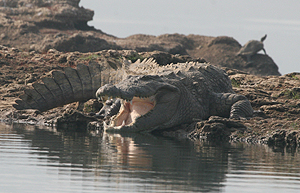 Black-bellied Tern. With patience we also had fair looks at a Ganges River Dolphin, a good sized individual which leapt a bit out of the water as well as rising to the water surface where we could hear it breathe. We had a bit of an adventure as our driver had ventured out onto deep sand. Despite his best efforts the bus would NOT move, and Avi elected to call in jeeps to our rescue while locals helped to dislodge the bus. Now we could experience the buzz of rural life at eye-level as we navigated busy streets. Lunch in our quiet lodge was just the thing. Afterwards several elected to take naps. Peg was down with ‘Delhi belly’ at this point, but the others elected to go see a fascinating historic site. Avi showed them a long line of temples, one still showing intricate interior paintings. He also took them into a village where they could walk amid food vendors and local merchants – which everyone thoroughly enjoyed.
Black-bellied Tern. With patience we also had fair looks at a Ganges River Dolphin, a good sized individual which leapt a bit out of the water as well as rising to the water surface where we could hear it breathe. We had a bit of an adventure as our driver had ventured out onto deep sand. Despite his best efforts the bus would NOT move, and Avi elected to call in jeeps to our rescue while locals helped to dislodge the bus. Now we could experience the buzz of rural life at eye-level as we navigated busy streets. Lunch in our quiet lodge was just the thing. Afterwards several elected to take naps. Peg was down with ‘Delhi belly’ at this point, but the others elected to go see a fascinating historic site. Avi showed them a long line of temples, one still showing intricate interior paintings. He also took them into a village where they could walk amid food vendors and local merchants – which everyone thoroughly enjoyed.
Friday, November 28 - Chambal River / Bear Sanctuary / Return to Delhi
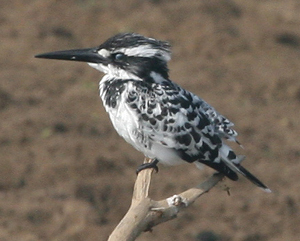 We had a leisurely breakfast at Chambal River and packed up for what would mainly be a travel day as we returned to Delhi. Near Agra we visited the Bear Sanctuary, where a non-profit group has provided refuge to bears taken from the wild, enslaved by gypsies often under cruel conditions. The program has been very successful in working to end the practice of using bears to dance for tourists as a source of income. They give incentives for the gypsies to rebuild their lives and for no more bears to be taken from the wild. It was both sad and heartwarming to learn of the bears' plight. Land around the Bear Sanctuary holds several ponds and trails, and we did a bit of birding. First we made a mad dash to see a fairly well hidden but HUGE Indian Rock Python to which a local guide had alerted us. We also enjoyed looks at a lovely species found by Linda, the Verditer Flycatcher. We had hoped to find pelicans, but knew we had many hours of travel ahead, so we gave up our search to head north.With traffic and a long line at the state border, we got to Delhi later than expected, but several intrepid members of the group ventured back out to dinner with Pat and Aryuna at their lovely home. They went all out, and we had a perfect evening with great conversation, joined by two friends of theirs who were on holiday from work in Southern India.
We had a leisurely breakfast at Chambal River and packed up for what would mainly be a travel day as we returned to Delhi. Near Agra we visited the Bear Sanctuary, where a non-profit group has provided refuge to bears taken from the wild, enslaved by gypsies often under cruel conditions. The program has been very successful in working to end the practice of using bears to dance for tourists as a source of income. They give incentives for the gypsies to rebuild their lives and for no more bears to be taken from the wild. It was both sad and heartwarming to learn of the bears' plight. Land around the Bear Sanctuary holds several ponds and trails, and we did a bit of birding. First we made a mad dash to see a fairly well hidden but HUGE Indian Rock Python to which a local guide had alerted us. We also enjoyed looks at a lovely species found by Linda, the Verditer Flycatcher. We had hoped to find pelicans, but knew we had many hours of travel ahead, so we gave up our search to head north.With traffic and a long line at the state border, we got to Delhi later than expected, but several intrepid members of the group ventured back out to dinner with Pat and Aryuna at their lovely home. They went all out, and we had a perfect evening with great conversation, joined by two friends of theirs who were on holiday from work in Southern India.
Saturday, November 29 - Flight to Jabalpur / Kanha National Park
We got an early start to catch the morning flight out to Jabalpur as we wanted to do an afternoon safari upon reaching Kanha. All went smoothly and we were met on schedule by our drivers in comfortable luxury taxis. Avi stopped almost immediately to pull out two new species for us, Rufous-tailed Lark and Ashy-crowned Finch Lark. He then delighted us with a stop at a local restaurant where we were able to try food from Southern India. He ordered for us to ease confusion and soon we were piling spicy goodies onto large crepe-like pancakes known as Dosa – yum! We were able to get out of town fairly quickly, and all of us marveled at what seemed like a serene level of road chaos compared to Delhi. New were the fancy teams of working cattle pulling a myriad variety of goods. We passed large herds of goats and several wetlands, areas teaming with waterfowl. At our rest stop we found a lovely butterfly known as the Chocolate Pansy and found a rather elusive Green Warbler singing high in a tree. After the rest stop we drove through some wooded areas, then past some fascinating 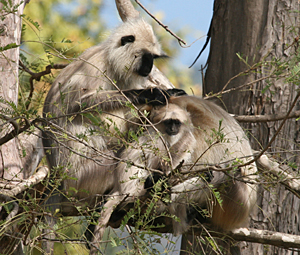 volcanic rock areas, and arrived at the Tuli Tiger Resort in time to freshen up quickly and head out for our afternoon safari. The lodge was lovely, with a pool, garden restaurant and spa and large, tastefully decorated rooms. We had great hopes of finding Tigers over the course of the next five days. We had other hopes as well, but that would be our main focus, with all other species being regarded as a bonus. Those of us familiar with an African safari were at first horrified to see the number of jeeps lined up at the entrance gate, but soon learned their system was to close the park mid-day, and upon entry the jeeps would fan out to a more tolerable level. We each picked up a park guide to ride with us as we searched for animals, insuring both our good conduct and employment for local people. Our travel was restricted to roads, and to find predators our guides and drivers listened intently to alarm calls made by deer and monkeys. This afternoon’s alarm calls let us find Leopards! These are sometimes more difficult to spot here than Tigers and here on our first day we found three. We also found a number of new bird species and got a feel for the road network and landscape we would explore in further detail.
volcanic rock areas, and arrived at the Tuli Tiger Resort in time to freshen up quickly and head out for our afternoon safari. The lodge was lovely, with a pool, garden restaurant and spa and large, tastefully decorated rooms. We had great hopes of finding Tigers over the course of the next five days. We had other hopes as well, but that would be our main focus, with all other species being regarded as a bonus. Those of us familiar with an African safari were at first horrified to see the number of jeeps lined up at the entrance gate, but soon learned their system was to close the park mid-day, and upon entry the jeeps would fan out to a more tolerable level. We each picked up a park guide to ride with us as we searched for animals, insuring both our good conduct and employment for local people. Our travel was restricted to roads, and to find predators our guides and drivers listened intently to alarm calls made by deer and monkeys. This afternoon’s alarm calls let us find Leopards! These are sometimes more difficult to spot here than Tigers and here on our first day we found three. We also found a number of new bird species and got a feel for the road network and landscape we would explore in further detail.
Sunday, November 30 - Thursday, December 3 – Kanha National Park
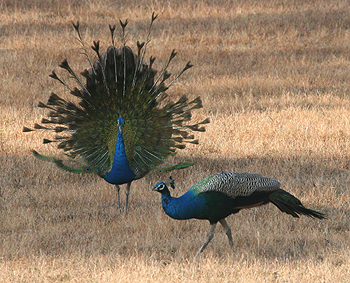 We started early each morning while in Kanha, then returned for lunch and a break and had the option to go out again in the afternoon. While no one wanted to miss anything, it was also tempting to relax or photograph around our lodge and several took advantage of massages and yoga offered at the spa. We passed through a local village coming and going to the park and at times we’d stop to see what local vendors were making and selling. One of our drivers even got a T-shirt shop to open especially for Fran, who at that time had not found shirts for her family – fun! Mornings were crisp and we would bundle up in blankets in the open jeeps. The sounds at dawn were marvelous as the Drongos, Treepies and other songbirds started calling. Our second morning we spotted a Sloth Bear making its way through tall grass at the back of a small system of meadows fairly close to the entrance. What a thrill! It was the size of a large Black Bear and ambled in the same fashion. Later in the week, one of our jeeps would see two together, likely a mother and almost grown youngster. Indian Peafowl were everywhere though it was hard not to stop repeatedly to photograph their displays and colors. The smaller birds were often clustered near small ponds or in bamboo thickets. We spent an afternoon watching Wild Dogs play – just incredible. Another driver tipped us off to a place they’d chosen to rest and we were some of the first in to see them. In mannerisms they seemed like bolder and broader foxes; in social encounters they behaved very much like wolves.
We started early each morning while in Kanha, then returned for lunch and a break and had the option to go out again in the afternoon. While no one wanted to miss anything, it was also tempting to relax or photograph around our lodge and several took advantage of massages and yoga offered at the spa. We passed through a local village coming and going to the park and at times we’d stop to see what local vendors were making and selling. One of our drivers even got a T-shirt shop to open especially for Fran, who at that time had not found shirts for her family – fun! Mornings were crisp and we would bundle up in blankets in the open jeeps. The sounds at dawn were marvelous as the Drongos, Treepies and other songbirds started calling. Our second morning we spotted a Sloth Bear making its way through tall grass at the back of a small system of meadows fairly close to the entrance. What a thrill! It was the size of a large Black Bear and ambled in the same fashion. Later in the week, one of our jeeps would see two together, likely a mother and almost grown youngster. Indian Peafowl were everywhere though it was hard not to stop repeatedly to photograph their displays and colors. The smaller birds were often clustered near small ponds or in bamboo thickets. We spent an afternoon watching Wild Dogs play – just incredible. Another driver tipped us off to a place they’d chosen to rest and we were some of the first in to see them. In mannerisms they seemed like bolder and broader foxes; in social encounters they behaved very much like wolves. 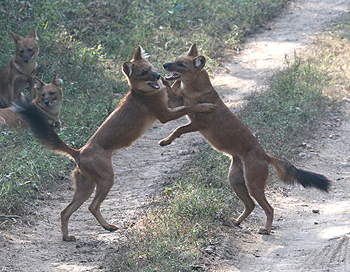 Watching a stealthy Jungle Cat was a thrill the final morning for one jeep. The landscape of Kanha was enchanting. We had not spent much time in woodlands so the thick canopy of trees was alluring. We enjoyed rides along a series of ridges favored by the Tigers and ideal for the more secretive Leopards, the latter of which we saw on five different occasions. Our guides were experts at tracking and often checked for fresh prints in the fine, sandy soils. They all were wonderful at finding birds, especially birds of prey. We found the nest of a pair of Crested Hawk Eagles which were arranging sticks on their massive nest. Another day, we stopped to photograph a juvenile Crested Serpent Eagle at very close range. One of the jeeps had four species of vultures soaring above the central meadows and the appearance of mature and juvenile Rufous-bellied Eagles were a treat even for Avi, our guide. Our three jeeps stayed together at times and at other times fanned out as some wished to look for birds and some remained steadfast in pursuit of Tigers. Eventually we were able to see Tigers in the wild, as well as at close range from the back of our elephants. Pradeep returned to a ridgeline road where we’d had very fresh tracks of Tiger one morning and his crew was rewarded with seeing a Tiger flash across the road. One morning after finishing our elephant ride, we watched as a Tigress got up from where she’d rested. She walked past a string of jeeps and sauntered regally up a small ridge. She then turned on a forest track where we watched her progress for some time as she made her way along the edge of a meadow. Our best views, at quite close range were from the elephants. These patient animals would wait for us to climb on, and then their handlers would steer them over to take turns visiting a resting Tiger. We had only a few minutes when close to the Tigers and it was luck of the draw if they were active or fast asleep bellies up to the sun. Mary Claire hit the jackpot and found a pair mating! She even recorded it with a digital movie. We wished we’d had a movie of Avi
Watching a stealthy Jungle Cat was a thrill the final morning for one jeep. The landscape of Kanha was enchanting. We had not spent much time in woodlands so the thick canopy of trees was alluring. We enjoyed rides along a series of ridges favored by the Tigers and ideal for the more secretive Leopards, the latter of which we saw on five different occasions. Our guides were experts at tracking and often checked for fresh prints in the fine, sandy soils. They all were wonderful at finding birds, especially birds of prey. We found the nest of a pair of Crested Hawk Eagles which were arranging sticks on their massive nest. Another day, we stopped to photograph a juvenile Crested Serpent Eagle at very close range. One of the jeeps had four species of vultures soaring above the central meadows and the appearance of mature and juvenile Rufous-bellied Eagles were a treat even for Avi, our guide. Our three jeeps stayed together at times and at other times fanned out as some wished to look for birds and some remained steadfast in pursuit of Tigers. Eventually we were able to see Tigers in the wild, as well as at close range from the back of our elephants. Pradeep returned to a ridgeline road where we’d had very fresh tracks of Tiger one morning and his crew was rewarded with seeing a Tiger flash across the road. One morning after finishing our elephant ride, we watched as a Tigress got up from where she’d rested. She walked past a string of jeeps and sauntered regally up a small ridge. She then turned on a forest track where we watched her progress for some time as she made her way along the edge of a meadow. Our best views, at quite close range were from the elephants. These patient animals would wait for us to climb on, and then their handlers would steer them over to take turns visiting a resting Tiger. We had only a few minutes when close to the Tigers and it was luck of the draw if they were active or fast asleep bellies up to the sun. Mary Claire hit the jackpot and found a pair mating! She even recorded it with a digital movie. We wished we’d had a movie of Avi 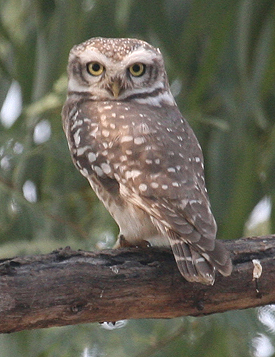 quizzing her at lunch and her animated descriptions of their sounds and antics. Our days passed quickly at Kanha. One day we traveled all the way through the park and out another entrance. When the park was closed, we took our mid-day rest at a lovely small tented safari camp where they prepared us an elegant lunch served under a row of mango trees. We napped in their spacious living room or out on the porch and Jane, the delightful hostess, brought out local textiles and games for us to get a shopping fix. Returning to the park we watched local women clearing gravel off the side of a road they were fixing, working hard in their bright and beautiful clothing. We found many new bird species here along with a host of mammals. It was fun to see and hear Red Junglefowl in the wild. The Indian Stone-curlews that roosted near the entrance gate were a treat. Alexandrine Parakeets were very common and we had two sightings of more secretive Sirkeer Malkoha. Many of our stops revealed inquisitive Jungle Owlets, one of which tried to steal a fish from a Common Kingfisher! We observed five species of woodpeckers and became quickly enamored with tiny Velvet-fronted Nuthatches. Very common, Jungle Babblers uttered their cacophony of song throughout the day. Indian Scimitar Babblers and Puff-throated Babblers required a bit of searching. We found Black-hooded Orioles and Greater Racket-tailed Drongos daily. Spotted Deer always attracted our attentions and on several occasions we encountered Gaur (Indian Bison). Two of the groups had small calves which appeared even smaller next to the massive bulls. Very memorable was the sighting of Marsh Deer pulling up pond weeds in the early light of dawn. Another strong memory will be the sighting of a hungry Jackal running and leaping as it pursued an Indian Peafowl one night at dusk. Our comfortable lodgings provided a nice place to rest and refresh between safaris and the staff was so welcoming. At dinner we’d gather around a patio fire-pit to exchange vibrant tales of our days.
quizzing her at lunch and her animated descriptions of their sounds and antics. Our days passed quickly at Kanha. One day we traveled all the way through the park and out another entrance. When the park was closed, we took our mid-day rest at a lovely small tented safari camp where they prepared us an elegant lunch served under a row of mango trees. We napped in their spacious living room or out on the porch and Jane, the delightful hostess, brought out local textiles and games for us to get a shopping fix. Returning to the park we watched local women clearing gravel off the side of a road they were fixing, working hard in their bright and beautiful clothing. We found many new bird species here along with a host of mammals. It was fun to see and hear Red Junglefowl in the wild. The Indian Stone-curlews that roosted near the entrance gate were a treat. Alexandrine Parakeets were very common and we had two sightings of more secretive Sirkeer Malkoha. Many of our stops revealed inquisitive Jungle Owlets, one of which tried to steal a fish from a Common Kingfisher! We observed five species of woodpeckers and became quickly enamored with tiny Velvet-fronted Nuthatches. Very common, Jungle Babblers uttered their cacophony of song throughout the day. Indian Scimitar Babblers and Puff-throated Babblers required a bit of searching. We found Black-hooded Orioles and Greater Racket-tailed Drongos daily. Spotted Deer always attracted our attentions and on several occasions we encountered Gaur (Indian Bison). Two of the groups had small calves which appeared even smaller next to the massive bulls. Very memorable was the sighting of Marsh Deer pulling up pond weeds in the early light of dawn. Another strong memory will be the sighting of a hungry Jackal running and leaping as it pursued an Indian Peafowl one night at dusk. Our comfortable lodgings provided a nice place to rest and refresh between safaris and the staff was so welcoming. At dinner we’d gather around a patio fire-pit to exchange vibrant tales of our days.
Thursday, December 4 - Final Safari / Return to Delhi
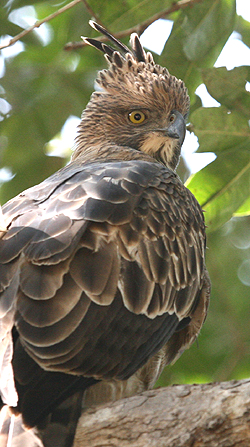 Our final safari, an optional event was enjoyed by about half the group. It was not easy to roll out of bed one more time at our wee-hour meeting time, but it was worthwhile. We had a beautiful sunrise as the Spangled Drongos called from their roost by the entry gate. Now all was familiar – the nest area of the Crescent Serpent Eagle, the huge tree that had once served as a village temple, the winding road through the bamboo-clad gully always good for birds like the Paradise Flycatcher and the Puff-throated Babbler. There was a lot of mist when we reached the meadows. We immediately heard very urgent alarm calls from a Spotted Deer. It turned out to be a doe with a young fawn; her intensity was something to behold. One could almost trace the Tiger’s movements as additional alarm calls went out. One of the elephant handlers came bounding over. Intent on tracking, he stopped for a moment to talk with several jeep drivers. We would not see this particular tiger this morning, but in trying to, one of the jeeps spotted a Jungle Cat. Keen-eyed Pradeep saw it leap through tall grass, and with luck our observers watched it come out into the open where it sat on a log, then trotted down the road and off into tall grass. Another of the jeeps found two Sloth Bears! And we all raced down the ridgeline when another driver alerted us to news of a male Tiger sitting on one of the lower roads. We missed it by mere minutes and only found the contented smiles of several photographers. Regardless of our miss, it was another magical, memorable time in Kanha. We returned for a nice hot breakfast, said goodbye to our lovely lodgings, packed our gear and were on our way mid-morning. Today’s drive was to Nagpur, located in the center of India. This seemed to be a modern small city; we saw several young women straddling their motorcycles, driving solo. Amid the crowds we contemplated that the population of India has doubled since the start of Project Tiger in the early 1970’s. What would happen to the wildlife and treasured places like Kanha in decades to come? At the local airport we caught small planes back to Delhi. Some of our group stayed on at the airport to catch International flights and others returned to the hotel we had started at, from which they’d explore Delhi in further detail in coming days.
Our final safari, an optional event was enjoyed by about half the group. It was not easy to roll out of bed one more time at our wee-hour meeting time, but it was worthwhile. We had a beautiful sunrise as the Spangled Drongos called from their roost by the entry gate. Now all was familiar – the nest area of the Crescent Serpent Eagle, the huge tree that had once served as a village temple, the winding road through the bamboo-clad gully always good for birds like the Paradise Flycatcher and the Puff-throated Babbler. There was a lot of mist when we reached the meadows. We immediately heard very urgent alarm calls from a Spotted Deer. It turned out to be a doe with a young fawn; her intensity was something to behold. One could almost trace the Tiger’s movements as additional alarm calls went out. One of the elephant handlers came bounding over. Intent on tracking, he stopped for a moment to talk with several jeep drivers. We would not see this particular tiger this morning, but in trying to, one of the jeeps spotted a Jungle Cat. Keen-eyed Pradeep saw it leap through tall grass, and with luck our observers watched it come out into the open where it sat on a log, then trotted down the road and off into tall grass. Another of the jeeps found two Sloth Bears! And we all raced down the ridgeline when another driver alerted us to news of a male Tiger sitting on one of the lower roads. We missed it by mere minutes and only found the contented smiles of several photographers. Regardless of our miss, it was another magical, memorable time in Kanha. We returned for a nice hot breakfast, said goodbye to our lovely lodgings, packed our gear and were on our way mid-morning. Today’s drive was to Nagpur, located in the center of India. This seemed to be a modern small city; we saw several young women straddling their motorcycles, driving solo. Amid the crowds we contemplated that the population of India has doubled since the start of Project Tiger in the early 1970’s. What would happen to the wildlife and treasured places like Kanha in decades to come? At the local airport we caught small planes back to Delhi. Some of our group stayed on at the airport to catch International flights and others returned to the hotel we had started at, from which they’d explore Delhi in further detail in coming days.
Friday, December 5 - Departures
We had ample time, tucked in our planes to replay the images of India – from Delhi traffic to Sloth Bears slipping through tall grass and woods, Wild Dogs boxing and elephants roaming under the careful eye of the keepers – intent on finding TIGERS. Beautiful birds of rainbow colors, birding by rickshaw, flavors of eggplant, spinach, hot bread from the oven…. What a nice group we had to share this venture, which went very smoothly with the careful planning of Gina Nichol of Sunrise Birding, LLC and Avi Sarkhel, our expert guide.
Report by Peg Abbott, Naturalist Journeys
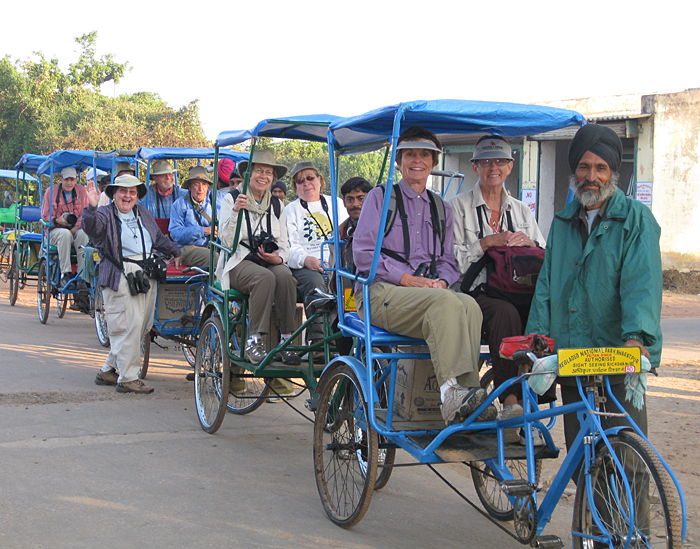
Birding by Rickshaw in Bharatpur! Photo by Peg Abbott.
Tour run in conjuction with:
Sunrise Birding, LLC
PO Box 274
Cos Cob, CT 06807-0274
USA
Tel: 1.203.453.6724
Email: [email protected]
www.sunrisebirding.com
Tour run in conjunction with:
Naturalist Journeys, LLC
P.O. Box 16545
Portal, AZ 85632
Email: [email protected]
www.naturalistjourneys.com
All photos © Peg Abbott.